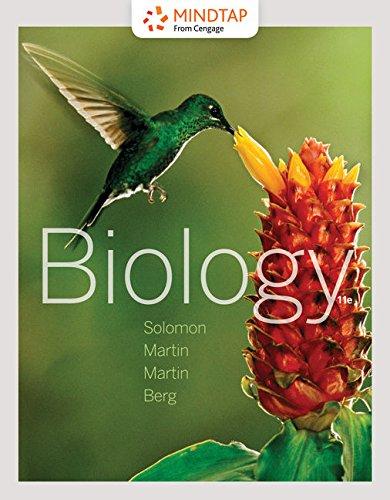
Concept explainers
Introduction: Plants exhibit two types of growth: primary growth and secondary growth. Plant’s primary growth involves growth in plant length. It usually occurs in roots and shoots. The apical meristem tissues allow this type of growth. On the other hand, the secondary growth involves growth in thickness. The lateral meristem assists in this type of growth. The secondary growth occurs in the parts of plant where the primary growth has been stopped. The two types of embryonic shoot present in
Answer to Problem 1TYU
Correct answer: Axillary buds are located in the upper angle between a leaf and the stem to which it is attached.
Hence, the correct answer is option (d).
Explanation of Solution
Reason for the correct answer:
The axillary buds, also called lateral buds, are embryonic shoots that are located at the axil of a leaf. The axil is the upper angle between a leaf and the stem to which it is attached. They are found only in dicots.
Option (d) is given as “in the upper angle between a leaf and the stem to which it is attached”.
The axillary buds are an embryonic shoot that is located in the axil of a leaf.
Hence, the correct answer is option (d).
Reasons for incorrect answers:
Option (a) is given as “at the tips of stems”.
The terminal buds are the primary growing point of the plant which is located at the tip of the stem.
Hence, option (a) is incorrect.
Option (b) is given as “in unusual places, such as on roots”.
The buds that are found in unusual places are called as adventitious buds.
Hence, option (b) is incorrect.
Option (c) is given as “in the region between two successive nodes”.
The region between two successive nodes is known as internode. The axillary buds are not found in internodes.
Hence, option (c) is incorrect.
Option (e) is given as “within the loosely arranged cells of lenticels”.
Lenticels are loose aggregate of cells in the periderm. They help in gaseous exchange between the atmosphere and the living tissue inside the bark. The axillary buds are not found in lenticels.
Hence, option (e) is incorrect.
Hence, options (a), (b), (c), and (e) are incorrect.
Axillary buds are found in between the leaf and stem.
Want to see more full solutions like this?
Chapter 35 Solutions
Mindtap Biology, 1 Term (6 Months) Printed Access Card For Solomon/martin/martin/berg's Biology, 11th
- ✓ Details Draw a protein that is embedded in a membrane (a transmembrane protein), label the lipid bilayer and the protein. Identify the areas of the lipid bilayer that are hydrophobic and hydrophilic. Draw a membrane with two transporters: a proton pump transporter that uses ATP to generate a proton gradient, and a second transporter that moves glucose by secondary active transport (cartoon-like is ok). It will be important to show protons moving in the correct direction, and that the transporter that is powered by secondary active transport is logically related to the proton pump.arrow_forwarddrawing chemical structure of ATP. please draw in and label whats asked. Thank you.arrow_forwardOutline the negative feedback loop that allows us to maintain a healthy water concentration in our blood. You may use diagram if you wisharrow_forward
- Give examples of fat soluble and non-fat soluble hormonesarrow_forwardJust click view full document and register so you can see the whole document. how do i access this. following from the previous question; https://www.bartleby.com/questions-and-answers/hi-hi-with-this-unit-assessment-psy4406-tp4-report-assessment-material-case-stydu-ms-alecia-moore.-o/5e09906a-5101-4297-a8f7-49449b0bb5a7. on Google this image comes up and i have signed/ payed for the service and unable to access the full document. are you able to copy and past to this response. please see the screenshot from google page. unfortunality its not allowing me attch the image can you please show me the mathmetic calculation/ workout for the reult sectionarrow_forwardIn tabular form, differentiate between reversible and irreversible cell injury.arrow_forward
- 1.)What cross will result in half homozygous dominant offspring and half heterozygous offspring? 2.) What cross will result in all heterozygous offspring?arrow_forward1.Steroids like testosterone and estrogen are nonpolar and large (~18 carbons). Steroids diffuse through membranes without transporters. Compare and contrast the remaining substances and circle the three substances that can diffuse through a membrane the fastest, without a transporter. Put a square around the other substance that can also diffuse through a membrane (1000x slower but also without a transporter). Molecule Steroid H+ CO₂ Glucose (C6H12O6) H₂O Na+ N₂ Size (Small/Big) Big Nonpolar/Polar/ Nonpolar lonizedarrow_forwardwhat are the answer from the bookarrow_forward

 Biology (MindTap Course List)BiologyISBN:9781337392938Author:Eldra Solomon, Charles Martin, Diana W. Martin, Linda R. BergPublisher:Cengage Learning
Biology (MindTap Course List)BiologyISBN:9781337392938Author:Eldra Solomon, Charles Martin, Diana W. Martin, Linda R. BergPublisher:Cengage Learning Biology: The Dynamic Science (MindTap Course List)BiologyISBN:9781305389892Author:Peter J. Russell, Paul E. Hertz, Beverly McMillanPublisher:Cengage Learning
Biology: The Dynamic Science (MindTap Course List)BiologyISBN:9781305389892Author:Peter J. Russell, Paul E. Hertz, Beverly McMillanPublisher:Cengage Learning Biology 2eBiologyISBN:9781947172517Author:Matthew Douglas, Jung Choi, Mary Ann ClarkPublisher:OpenStax
Biology 2eBiologyISBN:9781947172517Author:Matthew Douglas, Jung Choi, Mary Ann ClarkPublisher:OpenStax Biology Today and Tomorrow without Physiology (Mi...BiologyISBN:9781305117396Author:Cecie Starr, Christine Evers, Lisa StarrPublisher:Cengage Learning
Biology Today and Tomorrow without Physiology (Mi...BiologyISBN:9781305117396Author:Cecie Starr, Christine Evers, Lisa StarrPublisher:Cengage Learning





